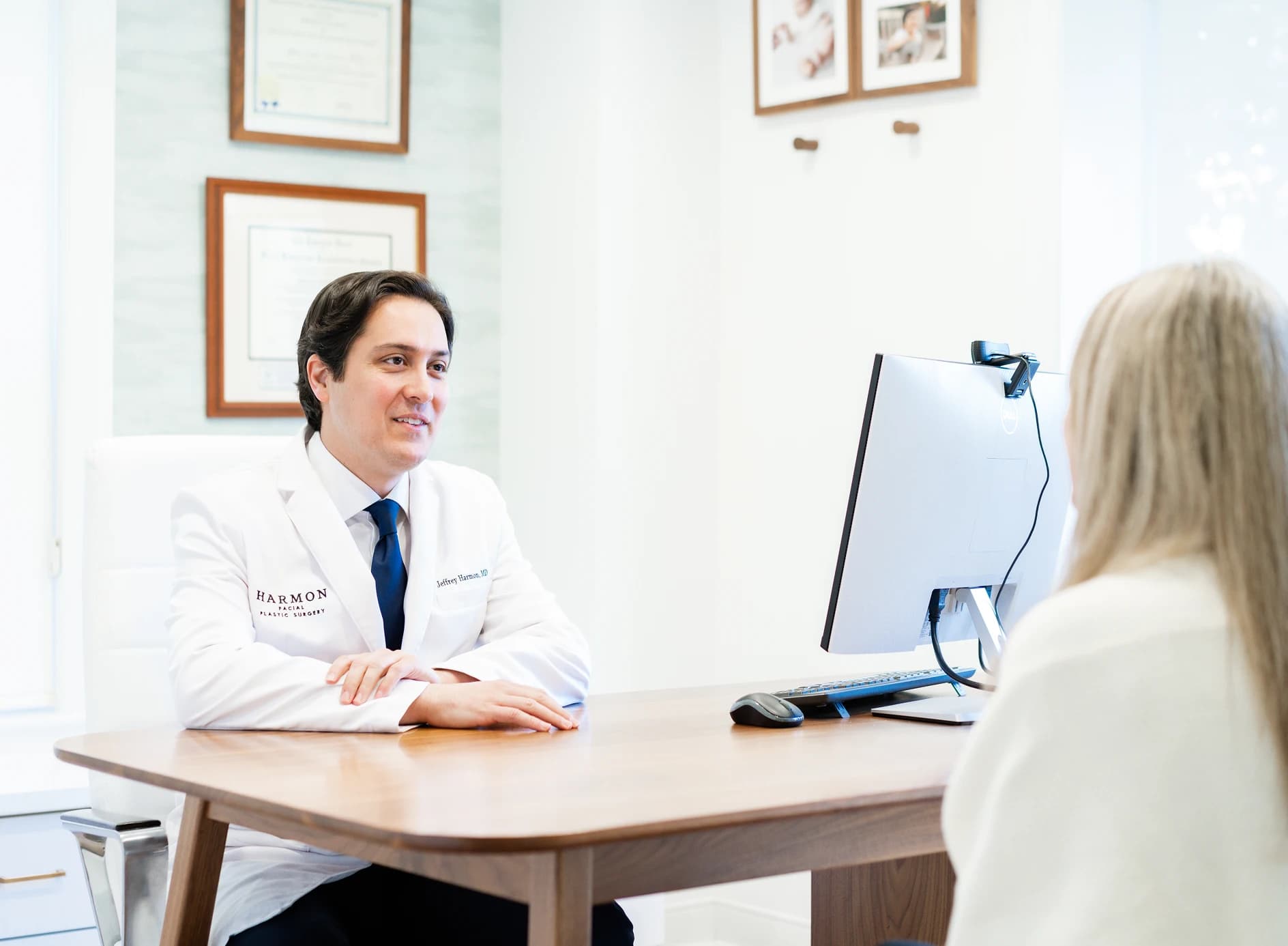Facial Fat Grafting
- Utilizes the patient's own cells to help improve facial volume and/or skin quality in a natural-appearing way
- Minimally invasive procedure that can be performed under local anesthesia or IV sedation
Contact Us
What is the Procedure?
Facial fat grafting is a surgical procedure intended to add volume and/or induce changes to the skin where it is placed on the face. Fat is removed from the body through a small incision using a blunt-tipped cannula. It is harvested from the abdomen, flanks and/or inner thighs. The fat is then purified. There are multiple methods for purifying fat including centrifugation, filtration, and washing. Purified fat is then transferred through instruments that make it smaller and more uniform in preparation for placement in the face. Depending on the thickness of the fat transferred, a blunt-tipped microcannula or needle can be used to perform fat grafting. Common areas of fat grafting include the temples, lower eyelids, cheeks, and the skin around the mouth.
What Conditions Does the Procedure Address?
A youthful-appearing face demonstrates a soft volume with smooth transitions between different anatomic regions. For example, youthful volume in the temples helps smooth the transition to the area around the lateral eyebrows. Also, youthful volume in the cheeks helps smooth the transition to the volume in the lower eyelids. Facial fat grafting helps address conditions related to a lack of volume in one or multiple areas of the face as well as skin changes that occur due to aging, chronic, excessive sun exposure, and other environmental factors than can harm the skin.
Why Choose Dr. Harmon
The desire for youthfulness is understandable. There is no area more important than the face. After all, the face cannot be hidden. It is how we present ourselves to the world. Dr. Harmon works with a refined eye and trained hands to develop a personalized treatment plan with you, utilizing advanced techniques in surgical and non-surgical care of the face, nose, eyes, neck and hair.
Fellowship trained facial plastic surgeons have a unique specialized skill set in performing surgical and non-surgical procedures on the face, nose, eyes, neck and hair. The pathway to becoming a facial plastic surgeon begins with five years of rigorous training in head and neck surgery. This training is focused on all aspects of surgery for the head and neck, in addition to aesthetic and reconstructive procedures.
A small pool of top performing graduates from head and neck surgery programs are then selected to complete sub-specialty training as a fellow in facial plastic and reconstructive surgery through the American Academy of Facial Plastic and Reconstructive Surgery (AAFPRS).
Dr. Harmon completed his fellowship in facial plastic surgery through the AAFPRS with the world-renowned facial plastic surgeon Dr. Andrew Jacono on Park Avenue in New York City. Dr. Jacono is world renowned for developing the extended deep plane facelift technique. Dr. Harmon is one of the few surgeons in the world, and the only surgeon in the Cincinnati area, fellowship trained in this technique by Dr. Jacono.
Quad A Accredited Surgery Suite
Harmon Facial Plastic Surgery is proud to have a Quad A accredited operating room and facility in our office. Our single-physician, single-specialty facility meets or exceeds the strict guidelines and high standards set forth by Quad A, demonstrating our strong commitment to patient safety and excellence in surgical care. We utilize the services of board-certified anesthesiology physicians only as well as our own personal clinical support staff to ensure the most comfortable, safest experience for our clients.
Types of Facial Fat Grafting Procedures
Broadly, there are two methods of facial fat grafting, microfat grafting and nanofat grafting. The differences between the methods include the number of steps taken to purify the fat and the intended effects of the procedure.
Microfat Grafting
Microfat grafting involves the processing of fat into a uniform material for the primary purpose of increasing the volume and, therefore, improving the contours of the area(s) injected. Areas that are commonly volumized include the temples and the cheeks.
Nanofat Grafting
Nanofat grafting involves the processing of fat, through additional steps, into a thinner material than microfat. As a result, nanofat can be injected more superficially than microfat. The primary purpose of nanofat grafting is to induce changes in the skin to improve its thickness and, therefore, fine lines, wrinkles, and textural abnormalities. Areas that are commonly injected with nanofat include the skin around the mouth and the lower eyelids.
Overview of the Procedure
The team at Harmon Facial Plastic Surgery works tirelessly to prepare patients well for their procedure. The time spent with patients and resources provided facilitates a smooth transition from the procedure through recovery. The following overview is a broad summary of the information provided to patients:
Procedure Consultation
Expect a detailed, informative discussion with Dr. Harmon about your concerns and aesthetic goals. He will develop a personalized treatment plan to address these concerns and goals.
Pre-Treatment Preparation
Patients receive a packet with detailed pre-operative instructions prior to surgery. This packet includes information on what supplements and medications to hold prior to surgery, activity restrictions, and what supplies are necessary for post-operative recovery. Prescriptions are sent prior to surgery with instructions on their use. Finally, if medical clearance is required, a form detailing the necessary clearance and testing is provided to present to their primary care provider.
Day of Treatment
Patients are instructed to arrive at the office in comfortable clothes. The surgical plan is discussed with the patient in detail. Paperwork is completed. Photos are usually taken pre-operatively. Finally, the patient meets the surgical team, which may include nurses, anesthesiologists, and or scrub technologists, depending on the procedure(s) and type of anesthesia used.
Follow-Up Appointment
Patients usually follow up seven (7) to ten (10) days after facial fat grafting. Sutures at the location(s) of fast harvesting are few and dissolve on their own. Subsequent follow-up appointments can vary and depend on multiple factors.
Social Readiness
The procedure involves only small incisions in the area(s) where fat is harvested and no incisions in the area(s) where fat is placed. The time to resolution of bruising and swelling varies and depends on multiple patient-specific factors. The incision(s) can take months to heal completely. However, many feel ready to socialize approximately seven (7) to ten (10) days after surgery.
Ideal Candidates for Facial Fat Grafting
Ideal candidates for facial fat grafting include patients who:
- Have lost volume in their cheeks with age
- Have lost volume in their temples with age
- Who have demonstrated a lack of volume in their cheeks from an early age
- Who have demonstrated a lack of volume in their temples from an early age
- Have developed thin skin around the mouth with fine lines and wrinkles
- Have developed thin skin around the lower eyelids with fine lines and wrinkles
Most candidates for facial fat grafting range in age from thirties (30s) to seventies (70s). A consultation is essential to determine candidacy for the procedure, because there may be factors that preclude this procedure for certain individuals. Reasonable expectations must be established about what facial fat grafting can and cannot accomplish as with all plastic surgery procedures. As with all facial plastic surgery procedures, results can vary.
Benefits of Facial Fat Grafting
Facial fat grafting helps address many age-related changes to the face. The procedure can help:
- Increase volume in areas of the face where it has been lost
- Increase volume in areas of the face where it is insufficient
- Improve the youthful contours of the face
- Improve skin quality and texture
Risks of Facial Fat Grafting
The risks of facial fat grafting include, but are not limited to:
- Bruising
- Swelling
- Infection
- Partial or complete resorption of fat
- Lumpiness or other surface imperfections
Combine Facial Fat Grafting with Other Facial Enhancements
Facial fat grafting complements other surgical and non-surgical procedures well. It complements other surgical procedures that lift drooping tissue (e.g. deep plane facelift, brow lift) by further emphasizing an elevation of the focal areas of facial aesthetics. It complements other non-surgical procedures by addressing age-related changes that develop concurrently but that they do not address.
Deep plane facelift
Combining facial fat grafting with a deep plane facelift may enhance both structure and volume, lifting deeper tissues while restoring youthful fullness. Together, they help create comprehensive, long-lasting facial rejuvenation with a natural softness and contour.
Brow lift
A brow lift can elevate and open the upper face, while facial fat grafting helps restore volume to hollowed temples and upper eyelids. This combination may refine the upper third of the face with youthful proportion and balance.
Blepharoplasty
While blepharoplasty refreshes the eye area by removing excess skin, facial fat grafting helps soften under-eye hollows and replenish volume around the tear troughs.
Laser skin resurfacing
Laser resurfacing supports improvement in skin tone, texture, and clarity. It may complement the volume restoration from fat grafting. Together, they help with surface renewal and structural rejuvenation for a glowing, youthful finish.
Botox©
Botox© help enhance the smoothing effects of fat grafting by targeting expression lines in dynamic areas like the forehead and around the eyes. It helps create a softer, refreshed appearance.

Book Your Consultation
Take the first step toward your aesthetic goals with a personalized consultation. Dr. Harmon will listen to your concerns, answer your questions, and guide you through your options. Schedule your consultation today and discover how expert care can make a difference.
Read More About

Fat Grafting Versus a Cheek (Midface) Lift: Which Procedure is the Most Appropriate for Me?
Fat grafting and a cheek lift procedure each address specific concerns about the cheek and the cheek-eyelid interface. It is important to seek not...

What are Common Areas to Receive Fat Augmentation in the Face?
Some individuals lose volume (i.e., fat) in their face as they age. Other individuals are born with poor volume and/or poor projection of their...
Addressing Smoker’s Lines (Peri-Oral Rhytids)
One of the most common concerns people express about their face as they age is the presence of smoker's lines, or peri-oral rhytids, around the...
Written by Dr. Harmon
Discover the expertise and compassionate care of Dr. Jeff Harmon, a fellowship-trained facial plastic surgeon deeply rooted in the Cincinnati community. A former collegiate athlete and Cornell University graduate, Dr. Harmon brings discipline, precision, and a global perspective to his surgical practice—refined through elite fellowship training in New York City.
Located in Hyde Park, Harmon Facial Plastic Surgery proudly serves patients throughout the Cincinnati area offering personalized facial aesthetics with world-class skill and a hometown heart.